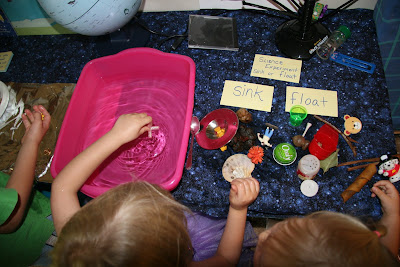I have lots of science experiments that we didn't
get to this past month. Since we're going on to
other units, I didn't want to do science experiments
daily. Instead, I have decided to set up a new science
center every Monday. That gives me time over the
weekend to gather the materials I need and to get
things set up.
On Thursdays, I plan to set up an "old" experiment
that we've done already out on the craft table. I'll have
the materials needed along with the procedure cards.
I've written the procedures of the
science experiments
we've done so far on index cards (you'll see them in
some of my photos). I punched a hole in the cards
and put them all on a key ring. I also added a
laminated photo of the experiment itself to the key
ring as a reminder of what we did.
Today I set up a center about whether things
sink or float.
Part I:
There were a heap of different objects I gathered
from around the house and outside (enough for
all three to be able to have LOTS of turns!). Before
putting their object into the water they had to decide
whether it would sink or float. I told them they had to
make a hypothesis about whether the object would
sink or float (I used that term and then told them
it means to guess/predict).
Part II:
Next, they had to go around the house and
gather five things they thought would sink and
five objects they thought would float. Then they
had to test their objects.
If the kids were older I would have had them record
their predictions and findings.






































